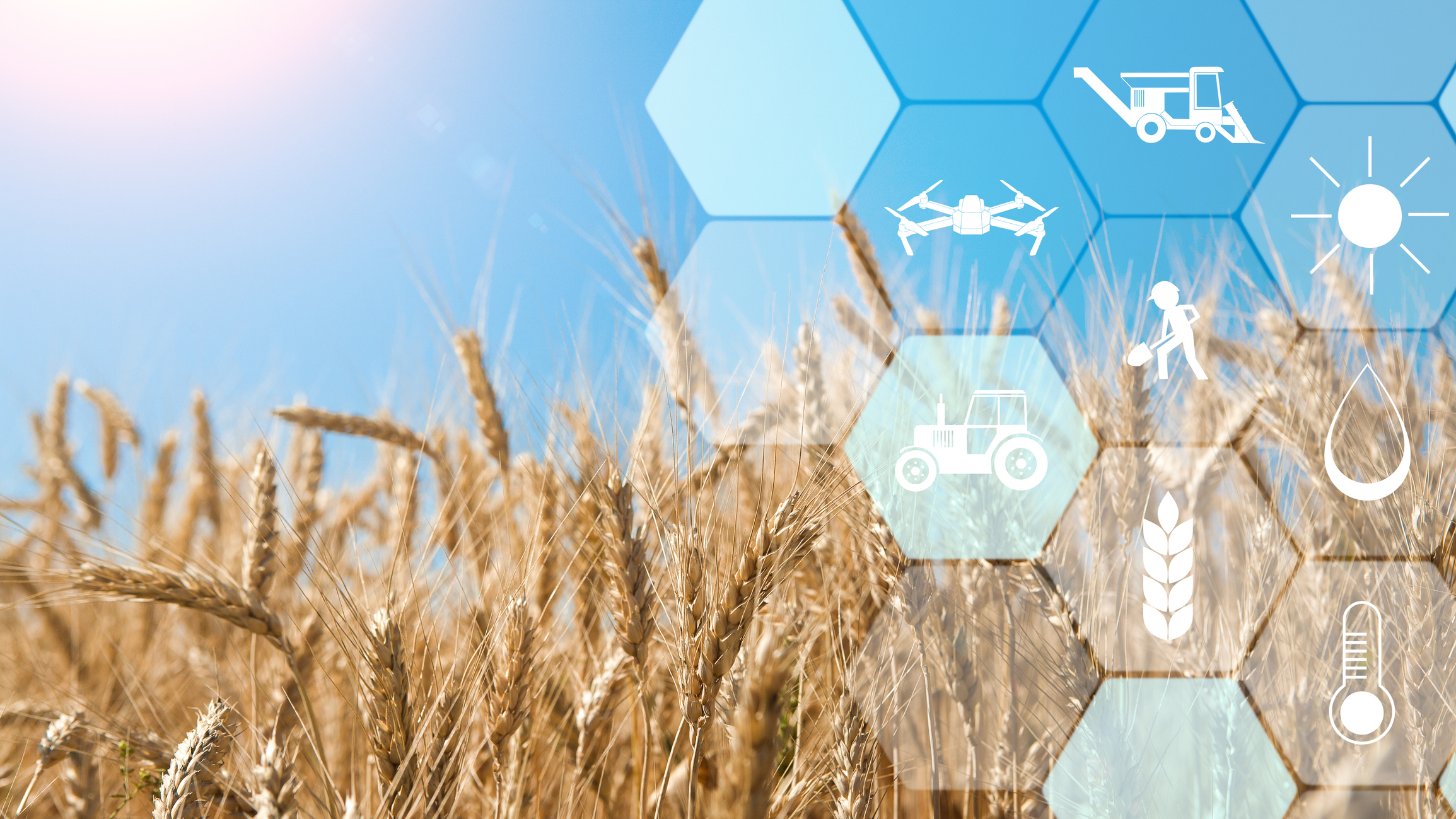
Convergence of digital technologies to meet Indian challenges
The COVID-19 pandemic has disrupted businesses across many sectors globally, including India. Nevertheless, the recent growth of the agritech market in India reflects its enormous unrealized potential. Increased rural Internet penetration and the greater affordability of digital technologies assisted by rising investor interest have led to the ongoing digital transformation of the farming ecosystem. But what are the most promising opportunities today, and how can India capture the full potential of agritech to drive the next green revolution?
Indian agritech market at a glance
Indian agriculture has come a long way from being state-focused in ensuring food security to becoming a major producer in the world. Indeed, Indian agriculture has the potential to become “the food bowl of the world” if India emphasizes (1) building efficiencies into the agricultural produce trade, (2) integrating quality standards as part of trade practices, and (3) optimizing production costs for price competitiveness.
Agriculture is the primary source of livelihood for about 58% of India’s population. This and allied sectors accounted for 17.8% of gross value added in India (at current prices) in the financial year 2020-2021. While COVID-induced lockdowns took a toll on industry and services, agriculture remained buoyant and helped sustain consumer demand. As per industry estimates, consumer spending in India will return to growth in 2021 after the pandemic-led contraction, expanding by as much as 6.6%. (Source: IBEF)
India’s food industry is poised for massive growth, increasing its contribution to world food trade every year due to its immense potential for value addition, particularly within food processing. The food processing industry is one of the largest in India, accounting for 32% of the country’s total food market and ranking fifth in terms of production, consumption, export, and expected growth. (Source: IBEF)
India also enjoyed significant growth in agriculture exports during 2020-2021. According to the Ministry of Commerce & Industry, the export of agriculture and allied products grew by 17% to US $41.25 billion in 2020-2021 after being stagnant for the past three years. Momentum is expected to sustain in the coming years with new businesses entering and converting challenges into opportunities. But several challenges have beset Indian agriculture for a long time, and solving them is vital to the growth of agritech and to overall development and rural prosperity. Challenges include low farm productivity, fragmented land holdings, lack of storage infrastructure, and high indebtedness – all which contribute to persistent agrarian distress. The fragmentation of holdings, where over 80% of Indian farmers till less than five hectares of land each, results in low economies of scale, limited access to technology, high marketing costs, and low productivity.
Changing contours of Indian agriculture
Agribusiness growth is being driven by rising demand, changes in food consumption habits, and a need to respond to environmental change. By 2030, India will have the world’s largest population, representing a third of Asia and 17% of the world. (Source: UN) This implies a massive growth in agricultural demand with income growth accelerating consumption of meat, fruits, and vegetables relative to cereals. This will call for commensurate shifts in output, adding pressure on natural resources.
Changing environmental conditions are steadily diminishing productivity in agriculture. According to the IPCC, greenhouse gas emissions have been growing at an alarming pace. The resultant rising temperatures have severe implications for ecosystems, affecting every aspect of food production and quality. New challenges in pest and disease management, unpredictable supply and rising cost of raw materials, among other issues, will emerge. To improve quality, reduce time from farm to fork, and ensure food safety, businesses and government must evaluate the development of, and risks along, the entire supply chain.
Challenges inhibiting growth of Indian agritech
Realizing the potential of India’s agritech sector will hinge on how effectively India can tackle the challenges holding it back. Factors inhibiting agritech growth include:
- Lack of financial services. Adoption of financial services (e.g., credit and insurance) is limited in Indian agriculture. In its 2019 report, the Reserve Bank of India estimated that only about 40% of farmers have access to formal credit despite many initiatives to include farmers in the banking system.
- Limited digital infrastructure. The penetration of digital infrastructure and digital records in the Indian agriculture value chain is limited. Robust digital infrastructure in the country, consisting of satellite imaging, soil health information, land record, and cropping pattern and frequency, can help make the value chain more effective.
- Issues in market linkage. Today, 85% of Indian farmers get prices 40% of, or lower than, the minimum support price, with no access to buyers outside the mandis. Issues in market linkage must be solved to strengthen the economic conditions of farmers.
Exploiting new technologies from adjacent industries
Technology advances in recent years are reengineering the value chain to solve both demand- and supply-side issues in the agri sector. Cutting-edge technologies (e.g., artificial intelligence, the Internet of Things [IoT], machine learning, big data, and blockchain) are poised to transform the sector by enabling higher productivity, superior quality, traceability, and real-time visibility while reducing the carbon footprint and increasing profits. These technologies can solve some persistent problems of Indian agriculture (see figure below).
An enhanced focus on cost, quality, and reliability are critical drivers of the increased adoption of precision agricultural technologies and in automation. The large volumes of data generated through farms can be captured, processed and valorised through advanced analytics to provide real-time insights to farmers and power timely and effective decision making, reducing production costs and improving yields. With labor becoming increasingly expensive and precision technology becoming more affordable via economies of scale, we envisage faster adoption of advanced solutions in Indian agriculture. We also foresee the growing startup community creating affordable quality solutions across innovation categories, which can be exported to other developing and developed geographies, (e.g., Africa and parts of the West), and the strengths of its agritech sector are becoming all the more evident.

India’s fast-growing agritech market
Agritech’s incredible pace of growth in India is turbocharged by the entry of younger agriculturists with a greater understanding of technologies, along with access to capital. Capturing the attention of numerous entrepreneurs and investors, agritech has made big strides in the following:
- Market linkage. Farmers are rapidly adopting market linkage solutions in India. They enable them to partner directly with the aggregators that sort and pack the produce and resell it to retailers or customers, providing better prices to farmers.
- Farm inputs. To increase productivity, different inputs including water, agrochemicals, labor, and capital must be used judiciously; farm inputs solution providers are increasingly using their agronomy knowledge, data, and technology to suggest solutions to Indian farmers.
- Precision farming. Poor agricultural practices and lack of knowledge of scientific farming techniques among Indian farmers have kept productivity below global benchmarks. Precision-farming solutions collect farm-specific data about soil, weather, pests, and so forth, by using IoT sensors or geospatial technology and combining analytical capabilities to provide timely insights. This information helps manage farming systems, often in real time, through precision application of inputs (e.g., agrochemicals and water).
- Farming-as-a-service. Farm mechanization in India is low, at 40%-45% compared to 95% in the US and 57% in China. (Source: The Economic Times) Offering services like on-demand machinery rental, field leveling, and pesticide spraying improves productivity.
- Financial services. Lack of access to organized credit, lack of collateral, and high interest by private lenders have impeded growth for most Indian farmers. Financial services solutions in agritech are tackling the issue by using technologies such as micropayments, secure banking systems on mobile phones, real-time market prices, and remote monitoring to ascertain the creditworthiness of farmers for small-ticket loans.

Beyond these, increased rural Internet penetration, access to technologies and devices, and a rise in supply chain challenges for farmers have paved the way for more than 1,000 startups in agritech subsectors (see figure below). These startups are trying to fix issues (e.g., land pooling), high interest rate loans, and inefficient cold chains, with the help of technology and innovative models.
In the last five years, funding has grown nearly 10 times, with more than $400 million of investment in 2020 from $40 million in 2016. The trend is expected to continue; funding could grow to $10 billion by 2030. Yet the potential of the Indian agritech sector has barely been tapped. Industry estimates of total addressable market for food processing and agritech amounts to $24 billion. Going by these estimates, current penetration of agritech in India is less than 1% of overall Indian agritech potential. Adequate investment, infrastructure, and innovation could help India create 25-30 million entrepreneurs in agriculture, increasing rural prosperity by an order of magnitude. (Source: Inc42)
The 3Is: innovation, infrastructure, and investment
Technology-led innovations supported by investments can bring India on par with its global peers. The focus needs to be on the 3Is: innovation, infrastructure, and investment:
- Innovation. In India, there is a considerable disparity in the adoption of digital agriculture technologies between global companies and those at the local or community scale. There is a need for innovative business models that provide viable digital solutions for small-scale farmers. Developing disruptive agritech business solutions will need more capital and the ability to link them with the market and consumer. Forming “innovation clusters” in regionally contiguous zones can enable a wider ecosystem for innovation by driving interfirm linkages, collaboration, and networks. With heightened economic activity and technology advancements, the clusters provide a budding platform to technology startups. To raise productivity, ensure food security, and become a net exporter of food products and intellectual property, India needs to promote innovation clusters with goal-oriented efforts (see sidebar).
- Infrastructure. Indian agriculture is characterized by a high level of pre-consumer waste, which partly explains why many in India still go hungry even though the country is a leading food producer. Food waste also harms the environment. Most ends up in landfills, where limited oxygen availability impedes it decomposition, creating methane, which is 28 times more harmful than CO2 . (Source: The Washington Post)
Large-scale investments are needed in post-harvest infrastructure, including near-farm warehouses and captive cold chains, to reduce waste. And supply chains between farmers and consumers need to be transformed. They are notoriously opaque and inefficient with numerous intermediaries, poor data collection, and institutionalized practices of adulteration and pilferage. And post-consumer waste should be avoided. Enabling digital technologies can improve traceability, reducing waste and operational delays for supply chain players.
Innovation clusters in action
- The Netherlands Food Valley, a region where international food companies, research institutes, and the Wageningen University and Research Centre are concentrated, is home to many food multinationals. Within the Food Valley, about 15,000 professionals engage in food-related sciences and technological development. The regions form a dynamic center of knowledge for the international food industry designed to enable food manufacturers and knowledge institutes to work together on innovative food concepts.
- Agri-horticulture park Innova was set up in Malur, Karnataka, India, with the motto to double farmer’s income by 2020. Horticulture parks bring best-in-class technologies/infrastructure to create and deliver value to both farmers and businesses by linking farmers and consumers. The food park’s focus is on making a positive and meaningful difference to farmers’ lives through business.
- Investments. A very low percentage of India’s farmers have access to finance from formal sources. Given the economic and social importance of agriculture to the economy, addressing fundamental financial challenges in agricultural and allied sectors is critical. Apart from microlending, extensive investments must be made in farmer training at the grassroots level. The experience of other countries and encouraging results of successful farmer education initiatives and collaboration with other value chain actors point the way to successful digitization of agriculture. Moreover, farmer’s training would allow better adoption of modern and sustainable farming practices.

